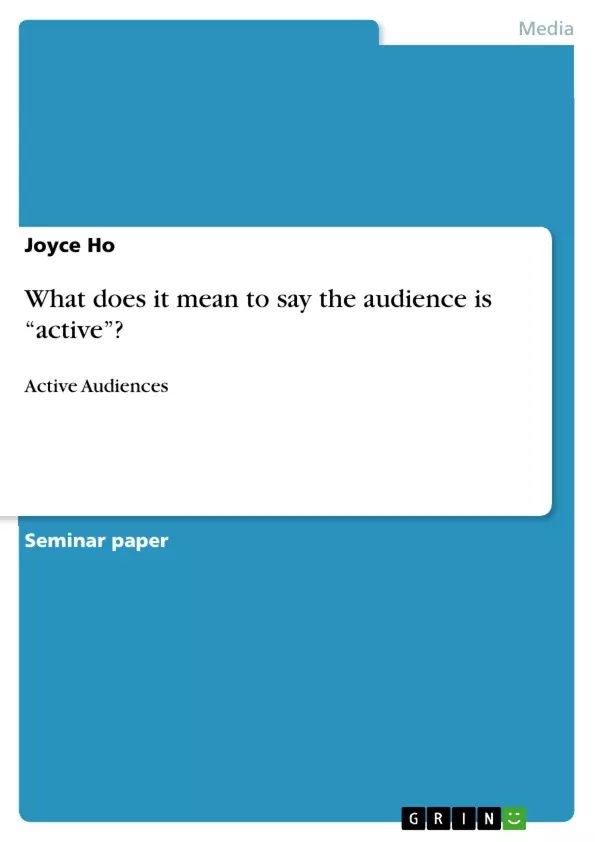People receive messages mainly from a large variety of medias, as audiences they are consuming their service through media appliances. According to Fischoff, people will consume, including buy, rend lease or steal media for two reasons, which is to be informed and to be entertained . As the general education level increases, audiences have more expectation on what media can offer them, there will not only be one-way communication from media to audiences, the action audiences would like to voice back and influence media are named “active audiences.” Traudt suggested that, audiences nowadays are more unique and they will bring a personal set of scale and filters to experience the media. And this scale and filets are based on audiences’ prior life experiences .
Table of Contents
- What does it mean to say the audience is "active"?
Objectives and Key Themes
This text explores the evolving role of the audience in media consumption, shifting from a passive recipient of information to an active participant and even content creator. The paper examines the impact of technological advancements, particularly the rise of the internet and social media, on this transformation.
- The evolution of audience roles from passive to active.
- The influence of technology on audience participation.
- The impact of social media on news consumption and dissemination.
- The changing power dynamic between media producers and consumers.
- The emergence of citizen journalism and its implications.
Chapter Summaries
What does it mean to say the audience is "active"?: This chapter delves into the concept of "active audiences," contrasting it with the traditional notion of passive audiences who merely receive information. It explores the perspectives of various scholars like Fischoff, who highlights the audience's dual motivations of information and entertainment, and Traudt, who emphasizes the individual experiences and filters that audiences bring to media consumption. The chapter also discusses the role of media in distributing information, highlighting the shift from one-way communication to a more interactive model influenced by factors such as increased education levels and the rise of new technologies. Examples such as television news reporting illustrate the traditional passive audience role, while the emergence of online platforms and social media highlight the increasing active participation of audiences in shaping media content and dissemination. The chapter emphasizes the impact of technology on audience agency, providing examples of how younger audiences' access to online news sources enables them to influence the information they consume and even participate in content creation.
Keywords
Active audience, passive audience, media consumption, technology, social media, internet, citizen journalism, news dissemination, power dynamics, audience participation.
Frequently Asked Questions: A Comprehensive Language Preview
What is the main topic of this text?
This text explores the evolving role of the audience in media consumption, focusing on the shift from a passive recipient of information to an active participant and even content creator. It examines the impact of technological advancements, especially the internet and social media, on this transformation.
What are the key themes explored in this text?
Key themes include the evolution of audience roles from passive to active; the influence of technology on audience participation; the impact of social media on news consumption and dissemination; the changing power dynamic between media producers and consumers; and the emergence of citizen journalism and its implications.
What is meant by an "active audience"?
The text contrasts the traditional notion of passive audiences (merely receiving information) with "active audiences." It discusses how active audiences bring their individual experiences and filters to media consumption, actively shaping media content and dissemination. This is influenced by factors such as increased education levels and the rise of new technologies. Examples of active audience participation include online engagement and content creation.
How does technology influence audience participation?
The text argues that technological advancements, particularly the internet and social media, are major drivers in the shift towards active audiences. Increased access to online news sources empowers audiences, allowing them to influence the information they consume and even participate in content creation. The traditional one-way communication model is replaced by a more interactive one.
What is the impact of social media on news consumption and dissemination?
Social media plays a significant role in shaping how news is consumed and disseminated. The text highlights the increased active participation of audiences in this process, enabled by the interactive nature of social media platforms. This also relates to the emergence of citizen journalism.
What is the changing power dynamic between media producers and consumers?
The text discusses a shift in the power dynamic between media producers and consumers. The rise of active audiences and citizen journalism challenges the traditional authority of media producers, empowering consumers to participate in and shape the media landscape.
What is citizen journalism and what are its implications?
The text introduces citizen journalism as a key implication of the shift towards active audiences. Citizen journalism refers to the participation of ordinary citizens in news gathering and dissemination, often through online platforms. This challenges traditional media structures and introduces new perspectives and voices into the media landscape.
What are the key chapters and their summaries?
The provided preview includes a chapter summary for "What does it mean to say the audience is 'active?'" This chapter explores the concept of active audiences, comparing it to passive audiences, and analyzing the role of technology and individual experiences in shaping audience engagement with media.
What are the keywords associated with this text?
Keywords include: Active audience, passive audience, media consumption, technology, social media, internet, citizen journalism, news dissemination, power dynamics, audience participation.
- Quote paper
- Joyce Ho (Author), 2011, What does it mean to say the audience is “active”?, Munich, GRIN Verlag, https://www.hausarbeiten.de/document/198787


